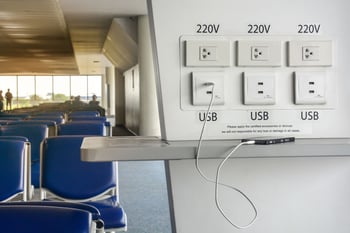Even though the latest desktop operating system from Microsoft is available and easier than ever to upgrade to, you might want to wait a second before clicking on that "Update Now?" prompt. Beyond the shiny, new interface (with its centered Start menu), what lurks within? Unfortunately, one of the more interesting things about this update is no less than the system requirements it will take to run it. And, probably the most frustrating aspect of the "simple" update process is that you may not find out about this until AFTER it's too late.
The unfortunate truth is, not every Windows PC or laptop out there will meet the minimum requirements needed to take advantage of what the new new OS has to offer. And some of the requirements are a bit unusual.
WHAT ARE THE REQUIREMENTS?
Now that security is a focus, rare hardware like a TPM 2.0 (Trusted Platform Module) is a must to make the new OS the most secure Microsoft has ever released. This will be frustrating to a lot of people looking to upgrade since they might not have the right hardware, even if they have a somewhat new laptop or powerful gaming PC.
To check to see whether your machine can handle Windows 11, check out the Microsoft page for Windows 11 System Requirements. At a minimum, what you'll find there includes:
| Processor | 1 gigahertz (GHz) or faster with 2 or more cores on a compatible 64-bit processor or System on a Chip (SoC). |
| RAM | 4 gigabyte (GB). |
| Storage | 64 GB or larger storage device Note: See below under “More information on storage space to keep Windows 11 up-to-date” for more details. |
| System firmware | UEFI, Secure Boot capable. Check here for information on how your PC might be able to meet this requirement. |
| TPM | Trusted Platform Module (TPM) version 2.0. Check here for instructions on how your PC might be enabled to meet this requirement. |
| Graphics card | Compatible with DirectX 12 or later with WDDM 2.0 driver. |
| Display | High definition (720p) display that is greater than 9” diagonally, 8 bits per color channel. |
| Internet connection and Microsoft account | Windows 11 Home edition requires internet connectivity and a Microsoft account. Switching a device out of Windows 11 Home in S mode also requires internet connectivity. Learn more about S mode here. For all Windows 11 editions, internet access is required to perform updates and to download and take advantage of some features. A Microsoft account is required for some features. |
Now, some of these don't seem all that unreasonable. Take for instance the 4GB of RAM requirement. While this seems innocent enough, there's no way anyone would be satisfied with the performance of a machine running Windows 11 with only 4GB of RAM. A real world minimum would be more in the 16GB range.
At the same time, it looks like Microsoft isn't going to budge on its requirement that your device is equipped with a TPM 2.0 in order to run a fully supported version of the new OS.
WHAT IS TPM?
TPM is essentially an aspect of hardware that deals with the security of your PC, making sure that nothing is compromised. It can be found on your motherboard as a very small chip that monitors any vulnerabilities, while also enabling features such as Bitlocker, found since Windows Vista.
A TPM-protected device requires its user to identify themselves. Depending on your systems, that identification can be accomplished in several ways: using a PIN code or a password, through bio-metric data such as fingerprints, via a smart card or a one-time password, or by a combination of those methods (note that this step usually happens before password managers come into play).
Whatever method you choose is the key to your system, and your data is safely locked away. TPM's job doesn't stop when the correct user is logged in. It can be used to encrypt the entire hard disk or just parts of it, it can authenticate online activities such as secure email and virtual private networking (VPN), and it can also be used to ensure that when a computer reaches the end of its life it doesn't go to the recycler/refurbisher with any confidential data still on it.
TPM-based encryption is exceptionally difficult to break. TPM-protected data can't be read without the correct authentication, and because encryption keys are processed independently by the TPM processor, it isn't vulnerable to operating system vulnerabilities or software-based hacking attacks.
Given the fact that TPM is historically a business/enterprise feature, it is therefore less common in DIY, custom-built and boutique-sourced rigs.
WHY IS IT NEEDED?
Microsoft has argued that the requirements for Windows 11 are in place for security reasons, so while the reasoning is justified, many of us will still be understandably frustrated that Microsoft is unlikely to change its stance on the matter.
If you attempt to install Windows 11 on a device that doesn't meet the system requirements then it's possible that you won't receive updates and that all future support will be dropped. If you try and force an installation anyway then some users have reported a pop-up window that asks you to sign a waiver that makes you acknowledge all damages to your PC due to a lack of compatibility will not be covered under your manufacturer's warranty.
WHAT NOW?
In addition to all of this, there's always the concern around the compatibility of legacy applications with a new operating system. As "seamless" as new operating systems are touted when they first appear, there's always that rogue application that just won't run which creates havoc on the end user and the IT support team.
That said, we HIGHLY recommend holding off updating individual machines to Windows 11 at this time and instead approach this like any other update - step back, plan for it, and convert in an an organized fashion. Visit with your IT team after they've had an opportunity to familiarize themselves with Windows 11. Let them tell you the pros and cons of upgrading your organization to Windows 11. Consider purchasing a license of Windows 11 for a computer so that your IT team can experience the new OS first hand. You might decide not to upgrade just yet. However, there may come a point where some of your programs might require an upgrade for it to work correctly.
Keep in mind though, Microsoft will support Windows 10 through October 14, 2025. So, we definitely have some time.
I hope this helps. Let me know what you think. Please share your thoughts in the Comment box below or send an email if you’d like to chat about this in more detail.
/fpa-logo-tagline.gif)







